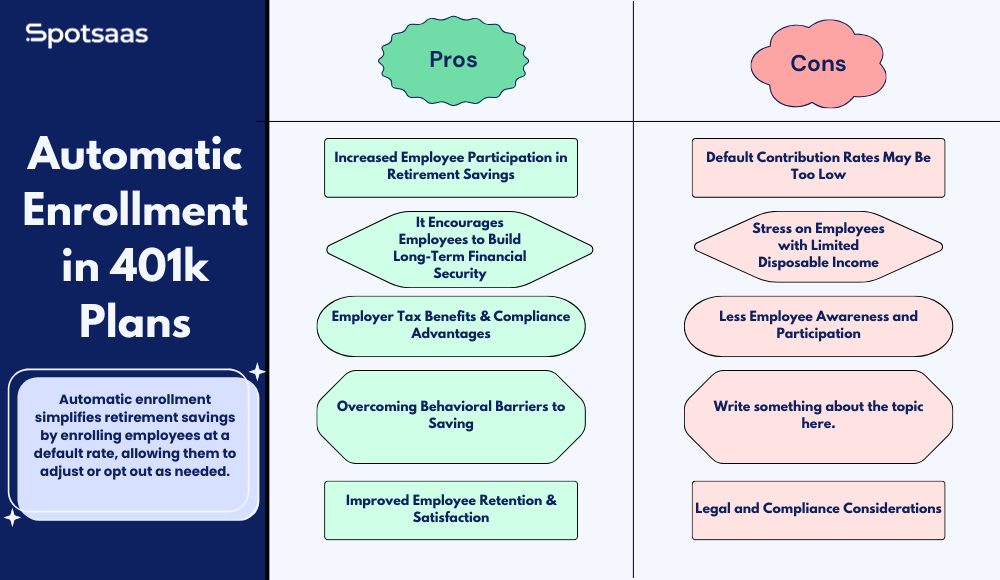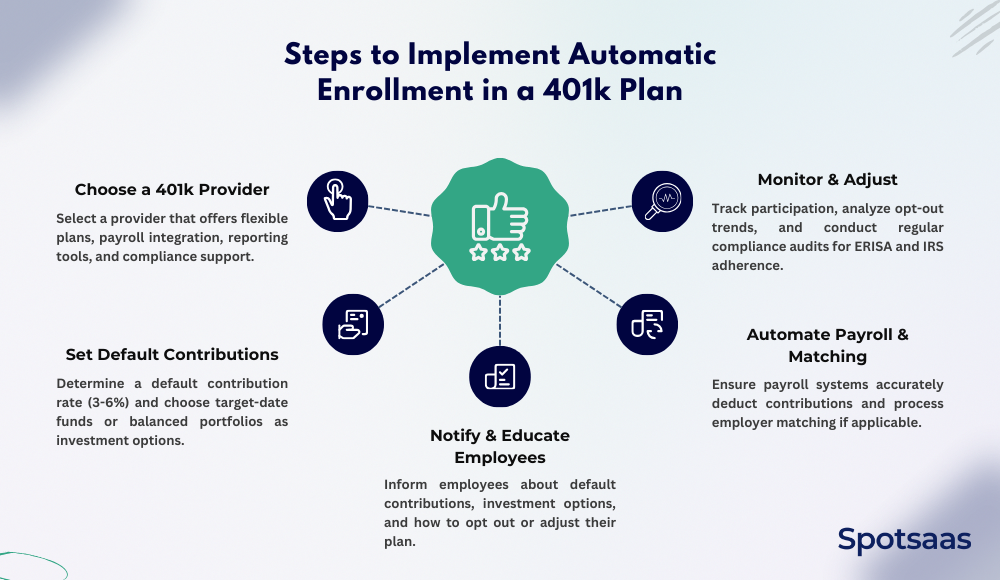With automatic enrollment, employees are put into a 401k plan, usually at a fixed contribution and investment selection rate, unless they opt out or wish to change contributions. One worker will see automatic deductions from their salary and have it placed in the fund; this takes the conscious decision away and allows for more employees to start saving.
Automatic enrollment thus shapes new conditions for setting company retirement programs. This is a great accelerator for building long-term savings for employees because it propounds the zero-little or no-automatic choices, which are commonly observed by behavioral finance principles.
A minor automatic action becomes a better financial habit. However, this approach offers sufficient advantages with a few challenges for employers and employees alike.
This work examines the benefits, drawbacks, and best practices of automatic enrollment in 401k plans, helping employers and employees make informed retirement savings decisions.
Understanding Automatic Enrollment in 401k Plans
The automatic enrollment process is intended to make saving for retirement easier by removing the requirement for employees to lift a finger. Rather than requiring workers to choose to participate in a 401k plan, employers automatically enroll eligible employees and start them at a default contribution rate so they can start saving from the first paycheck.
Employees will still have full control over their participation and will have the option to increase or decrease their contributions or opt not to participate altogether if they have such desires.
How Automatic Enrollment Works
Automatic enrollment in 401k plans allows employers to enroll employees by default, deducting a set percentage of their salary for retirement savings.
Automatic Enrollment of Employees
Employers enroll new employees in the company 401k plan automatically, with a default contribution rate of 3%–6% deducted from paychecks. Employees who previously opted out may be re-enrolled during specific enrollment periods.
Default Investment Selections
If employees don’t choose investments, contributions are placed in default options like target-date funds or balanced portfolios, ensuring professional management of retirement savings.
Opting Out or Adjusting Contributions
Employees can opt out or adjust contributions as needed. Those seeking personalized strategies can modify investment selections at any time.
Employer’s Role in Managing Contributions
Employers oversee plan administration, ensure ERISA compliance, and often match employee contributions (e.g., 50% match up to 6%), enhancing retirement savings.
By structuring these processes, employers simplify and encourage retirement planning.
Types of Automatic Enrollment
Employers can choose from different types of automatic enrollment strategies, each designed to boost retirement savings participation while offering flexibility to employees.
Basic Automatic Enrollment
- The most common approach is for employees to be automatically enrolled in the 401k plan at a default contribution rate unless they take action to opt-out.
- Helps employees start saving early without needing to make an immediate decision.
Automatic Escalation
- This feature automatically increases an employee’s contribution rate over time, usually by 1% annually, until it reaches a preset cap (e.g., 10-15% of salary).
- Employees can opt out of the escalation if they prefer to maintain a fixed contribution rate.
Re-Enrollment
- Employees who previously opted out are automatically re-enrolled in the 401k plan during periodic enrollment cycles (e.g., annually).
- This helps ensure employees reconsider their decision and have another opportunity to start saving.
Why Employers Use Automatic Enrollment
Automatic enrollment is gaining popularity among employers since:
- It actively encourages employees to take part in the retirement plan, especially for those who would delay or forget to enroll.
- It encourages long-term savings by effecting seamless automatic contributions.
- It helps remove decision-making from the financial inertia that prevents employee participation.
- It offers tax advantages and enables employers to comply with state-mandated retirement plan requirements.
By knowing how automatic enrollment works and available strategies, employers and employees will be able to make better-informed decisions about participation and management of their 401k plan.
Pros and Cons of Automatic Enrollment in 401k Plans

Pros of Automatic Enrollment in 401k Plans
Automatic enrollment removes barriers to 401k participation, helping employees save by default and ensuring long-term financial security.
Increased Employee Participation in Retirement Savings
Many employees, especially younger workers or those new to the workforce, may not actively sign up for a 401k plan on their own. Automatic enrollment takes care of this hurdle, ensuring that all eligible employees contribute from day one.
Employees have the option of adjusting those contributions or even opting out. However, many employees prefer to remain in a plan, promoting higher overall savings rates.
It Encourages Employees to Build Long-Term Financial Security
Automatic enrollment’s primary advantage is early savings among employees. Their money accumulates in their 401k plan faster with automatic enrollment since contributions begin early. Therefore, with compound interest, the earlier employees start contributing, the more they will benefit.
Regular contributions into a 401k plan significantly reduce the risk of any bouts of financial insecurity later in life, meaning that if employees have put away enough funds, they will have an excellent retirement.
Employer Tax Benefits & Compliance Advantages
Employers who employ auto-enrollment may get tax credits designed to inspire the creation of retirement savings programs for their employees. The SECURE Act, for instance, introduced tax credits for employers who adopted auto-enrollment in their retirement plans.
Some states require employers to offer retirement plans, and automatic enrollment helps meet these mandates.
The Very Ways of Overcoming Behavioral Barriers to Saving
Many employees are often guilty of procrastination when it relates to financial decisions. This stems from pure ignorance or insecurity about whether or not a decision arrived at is wholly nursed. With automatic enrollment, participation becomes a default, not a challenge.
Behavioral finance indicates that people tend to stick to default choices; therefore, they don’t opt out once they are enrolled in something. Automatic enrollment reduces decision paralysis by simplifying investment choices and encouraging long-term savings.
Improved Employee Retention & Satisfaction
A properly structured 401k plan increases employee job satisfaction and retention. Employees appreciate job benefits that support them financially; therefore, the automatic enrollment process signals that the employer cares about their future.
Offering a retirement savings plan as a standard benefit makes the company more attractive to job seekers; it improves morale within the workplace. Financially secure employees are also much more involved and productive people, which could only serve to benefit the workforce and the business.
Cons of Automatic Enrollment in 401k Plans
Considerable drawbacks attach to safe harbor automatic enrollment in plans among the merits. Employees will be informed of the pitfalls and may be able to render convincing knowledge to allow their employees to re-engineer the strategies.
Default Contribution Rates May Be Too Low
The greatest issue with automatic enrollment is that the default contribution rates tend to be much too low. Most plans start an employee at 3% of salary when the planned rate for a financially secure retirement lies somewhere between 10 and 15%.
Employees may assume the default contribution rate is enough and never adjust it for retirement needs. The net result is chronic under-saving for retirement, leading to a financially unprepared state when it is time for the employee to retire.
Stress on Employees with Limited Disposable Income
Low-income workers or workers facing financial hardship will find that any deduction taken from their paycheck makes things hard. While automatic enrollment encourages saving, some employees struggle to contribute due to essential living expenses.
Furthermore, it is possible that some workers won’t be reminded about their rights to change that contribution rate or opt out. Poor communication can leave employees confused about automatic enrollment, causing stress for those struggling financially.
Less Employee Awareness and Participation
Automatic enrollment simplifies participation but may lead to passive engagement, limiting active investment management. Many employees are unaware of how their contributions are invested or how it impacts their goals.
In addition, employees are probably not going to be able to understand how to get the maximum benefit out of a given program, that being employer matching or tax benefits, because of poor financial literacy for things beyond the basics.
Increased Employer Costs and Administrative Burden
From the employer’s point of view, automatic enrollment increases the costs and administrative burdens. Employers’ expenses on matching contributions will increase as the number of employees in the plan increases, which can get expensive quickly.
It will create a paperwork burden either because employees joined, requested to opt out, or compliance issues have arisen. The employer must also educate employees regarding the plan, the options available to them, and deliver financial educational materials.
Legal and Compliance Considerations
Employers must adhere to legal and regulatory requirements when offering automatic enrollment. There would be ERISA regulations to abide by, as well as additional compliance requirements imposed by some states.
There is a potential for legal liability due to a lack of appropriate notices to employees or improper handling of contributions owed. Employees could also contest their automatic enrollment if it is claimed they were not sufficiently apprised of the plan or how it functioned.
5 Key Steps to Implement Automatic Enrollment in a 401k Plan
Employers interested in providing automatic enrollment in their 401k plans must follow a well-outlined process to guarantee compliance and seamless implementation. The following are five vital steps.

Select a 401k Plan Provider That Supports Automatic Enrollment
When selecting a provider, Rating Employers should evaluate plan flexibility, investment options, administrative support, and compliance features. A good provider offers easy payroll integration, reporting tools, and automatic escalation options—all of which help improve retirement savings over time.
Set Default Contribution Rates & Investment Options
One of the biggest decisions about automatic enrollment is what contribution rate will be the default for employees. Most employers set this somewhere between 3 and 6 percent of an employee’s salary.
Target-date funds, balanced portfolios, or managed accounts may work well here, helping employees invest wisely without needing to make complex financial decisions.
Notify Employees & Provide Clear Education
Employers must notify employees of automatic enrollment, including:
- Default contribution rate and payroll deduction.
- Investment options are provided to employees who do not make an election.
- How employees can opt out or change contribution or investment options.
Webinars, FAQs, and one-on-one consultations on educational topics related to financial can help increase general awareness of the program and accessibility for employees to enroll in the plan voluntarily.
Set Up Payroll Deductions & Employer Matching
Payroll must correctly deduct the employee contributions automatically in case a smooth enrollment process is to be achieved, integrated with the system of a particular payroll. In case employer matching is offered, that system also must calculate the amount correctly and deposit it.
Monitor and Decide- Compliance and Effectiveness Adjustments
Following the implementation, it is important that employers monitor the level of participation and analyze the opt-out trends to determine the effectiveness of automatic enrollment.
Also, it is necessary to be ERISA and IRS-compliant. Therefore, periodic reviews and audits of the plans have to be put into practice by the employers to ensure proper documentation, rewards contribution, and legality.
Best Practices for Employers Implementing Automatic Enrollment
Employers, while implementing automatic enrollment in 401k plans, must place both the employee benefit and organizational benefit in a balance. A well-structured plan encourages savings, improves participation, and enhances financial security.
However, automatic enrollment alone is not enough; best practices should be applied to make automatic enrollment effective and respond to anticipated concerns.
Set Higher Default Contribution Rates with Automatic Escalation
Many plans set default contribution rates at 3%, but this may not be sufficient for long-term retirement security. Employers should consider starting at a 5-6% contribution rate to help employees build stronger savings from the beginning.
Additionally, implementing automatic escalation—where contributions gradually increase each year—encourages employees to save more without requiring active adjustments.
Provide Clear Employee Communication & Education
One of the biggest challenges with automatic enrollment is ensuring that employees understand the plan and their options. Without clear communication, employees may not realize they can adjust contributions or investment choices. Employers should provide easy-to-understand materials that explain:
- How automatic enrollment works
- Contribution rates and employer matching
- Investment options and long-term benefits of saving
Offer Diverse Investment Options
Not all employees have the same risk tolerance or investment preferences. Employers should ensure that 401k plans include a variety of well-diversified investment options, including:
- Target-date funds for those who prefer automatic asset allocation
- Risk-based portfolios for employees who want investments tailored to their comfort level
- Managed funds for individuals who prefer expert-managed options
Allow Employees Flexibility to Adjust Contributions
While automatic enrollment simplifies savings, employees should have the flexibility to adjust their contributions rather than feel locked into a default rate. Employers should:
- Make it easy for employees to increase, decrease, or pause contributions as needed
- Ensure employees understand they can change their contribution rate at any time
- Provide a straightforward opt-out process for those who choose not to participate
By offering flexibility, employers empower employees to take control of their retirement savings while benefiting from the automatic enrollment structure.
Monitor and Adjust the Plan Based on Employee Needs
Employee engagement and retirement needs evolve over time, so employers should regularly review and refine their automatic enrollment strategy. This includes:
- Tracking participation rates to assess plan effectiveness
- Gathering employee feedback on contribution levels and investment options
- Adjusting default settings, communication strategies, and education programs based on employee behavior
Conclusion
Automatic enrollment in 401k plans by providers boosts retirement savings, but its effectiveness depends on proper implementation. Employers should set higher default contribution rates, provide educational resources, and offer various investment options so that employees can make informed economic decisions.
Flexibility for the employees to make some adjustments to their contribution and continuous plan monitoring would aid in increasing participation and long-term financial security. By being proactive, employers help their employees build a solid retirement, thereby creating a more financially secure and engaged workplace.
A well-managed plan not only benefits employees but also strengthens the company’s reputation as a supportive employer. Encouraging financial well-being fosters employee loyalty, productivity, and overall job satisfaction.
Frequently Asked Questions
What is automatic enrollment in a 401k plan?
Automatic enrollment is a feature that allows employers to enroll employees in a 401k plan by default, deducting a preset percentage of their salary for retirement savings unless they choose to opt-out.
How does automatic enrollment benefit employees?
It simplifies the process of saving for retirement, removes the need for employees to take action, and helps them start building long-term financial security. It also ensures they don’t miss out on employer-matching contributions.
What happens if an employee doesn’t want to participate?
Employees can opt out of automatic enrollment if they do not wish to contribute to their 401k plan. They can also adjust their contribution rate or investment selections at any time.
What investment options are available under automatic enrollment?
Most plans use target-date funds or balanced portfolios as default investment options. Employees can switch to other investment choices based on their risk tolerance and preferences.




